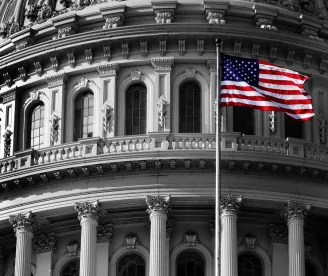POTUS Releases FY 2023 Budget. This week, President Biden released his budget for fiscal year (FY) 2023, which begins on October 1, 2022. As the Buzz has written many times in the past, because the U.S. Congress has the “power of the purse” and is solely responsible for establishing government funding levels, presidential budgets are, in reality, aspirational documents containing presidential spending preferences. Of note for labor and employment spending: the FY 2023 budget would provide the National Labor Relations Board with $319 million—up 16 percent from the roughly $274 million that it has annually received since 2014. With the November elections looming, and considering the fact that federal spending is always a contentious fight in Congress (recall that funding for FY 2022 was only agreed to last month), this budget is merely the first step in a series of lengthy negotiations.
Senate Rejects DOL Nominee. On March 30, 2022, the U.S. Senate voted against advancing the nomination of David Weil to be administrator of the U.S. Department of Labor’s (DOL) Wage and Hour Division. The procedural vote effectively defeats Weil’s nomination. Weil previously served as former President Obama’s wage and hour administrator from 2014 to 2017. In that role, he advanced policy changes relating to overtime, as well as tests for joint employer and independent contractor status that drew criticism—and legal challenges—from the business community. No word yet on whether President Biden will nominate another candidate for the position. Of course, the DOL can proceed with its enforcement and regulatory agendas in the absence of a confirmed wage and hour administrator, but it’s a bit like a college basketball team playing in the national championship without its coach: it can play the game, but perhaps not as effectively.
Retirement Bill Passes House. It is not every day that the U.S. House of Representatives passes legislation by a vote count of 414–5, but that was the vote tally this week when the House passed the Securing a Strong Retirement Act of 2022 (H.R. 2954). The bill, which combines multiple separate bills, builds on 2019’s Setting Every Community Up for Retirement Enhancement (SECURE) Act and is intended to make it easier for workers to save for retirement. Despite bipartisan support for the bill, there is some concern within the business community regarding provisions that would require the distribution of hard-copy statements to plan participants, as well as require automatic enrollment. The bill now heads to the U.S. Senate. Coincidentally (or perhaps not), the U.S. Senate Committee on Health, Education, Labor, and Pensions held a hearing this week on the issue of retirement, during which several concepts contained in the bill were discussed.
OSHA Proposes New Recordkeeping Reporting Requirements. For the third time in three consecutive presidential administrations, the Occupational Safety and Health Administration (OSHA) will attempt to change employers’ injury and illness recordkeeping requirements. On March 30, 2022, OSHA published a notice of proposed rulemaking that would “require establishments with 100 or more employees in certain designated industries to electronically submit information from their OSHA Forms 300, 301, and 300A to OSHA once a year.” The designated industries include agriculture, construction, manufacturing, retail, transportation, healthcare, among others. OSHA proposes “to require establishments to include their company name[s] when making electronic submissions to OSHA,” and the agency states that it “intends to post the data from the proposed annual electronic submission requirement on a public website.” The agency further states that it intends to “remov[e] information that reasonably identifies individuals” prior to posting such data publicly. The proposal is similar to a 2016 rule that was amended in 2019. Public comments are due on or before May 31, 2022.
OFCCP Rescinds Directives Aimed at Transparency, Efficiency. The Office of Federal Contract Compliance Programs (OFCCP) continues to advance policy directives that provide the agency with more power with regard to investigating federal contractors. This week, OFCCP issued Directive 2022-02, “Effective Compliance Evaluations and Enforcement.” The directive rescinds four Trump-era OFCCP directives focused on “CERT” principles adopted in 2018 and 2020— Certainty, Efficiency, Recognition, and Transparency—and replaces them with a policy approach providing OFCCP with access and information during contractor compliance evaluations. Highlights of the directive include the following policies and procedures that OFCCP will pursue during these investigations:
-
OFCCP will be “enhancing its neutral scheduling procedures” to ensure that a “broader universe of contractors and subcontractors” are selected for compliance evaluations.
-
OFCCP will implement strict deadlines within which employers must respond to data requests that may be excused only in “extraordinary circumstances.”
-
OFCCP will expand investigations to include as many establishments and employees as possible, as long as the agency can identify “similar practices to those identified during compliance evaluations of the scheduled establishments.”
-
During investigations, OFCCP may directly contact employees “without the contractor serving as an intermediary,” and “when OFCCP is interviewing nonmanagement personnel, the contractor does not have the right to have a representative present.”
Statues, not Statutes. This week, the House of Representatives passed H.R. 4814, “[t]o obtain and direct the placement in the Capitol or on the Capitol Grounds of a statue to honor Associate Justice of the Supreme Court of the United States Sandra Day O’Connor and a statue to honor Associate Justice of the Supreme Court of the United States Ruth Bader Ginsburg.” A similar bill has already passed the Senate, and President Biden is expected to sign the bill. There are more than 260 sculptures in the U.S. Capitol, but only 14 are of women. The actions this week are a small but significant step toward correcting this imbalance.




 />i
/>i
